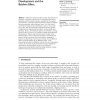Free Online Productivity Tools
i2Speak
i2Symbol
i2OCR
iTex2Img
iWeb2Print
iWeb2Shot
i2Type
iPdf2Split
iPdf2Merge
i2Bopomofo
i2Arabic
i2Style
i2Image
i2PDF
iLatex2Rtf
Sci2ools
ALIFE
2004
2004
Development and the Baldwin Effect
Baldwin's classic hypothesis states that behavioral plasticity can speed evolution by (a) smoothing the fitness landscape and (b) indirect genetic assimilation of acquired characteristics. This latter phase demands a strong correlation between genotype and phenotype space. But the natural world shows signs of this correlation at only a very coarse level, since the intervening developmental process greatly complicates the mapping from genetics to physiology and ethology. Hence, development appears to preclude a strong Baldwin effect. However, by adding a simple developmental mechanism to Hinton and Nowlan's classic model of the Baldwin effect, and by allowing evolution to determine the proper balance between direct and indirect mapping of genome to phenotype, this research reveals several different effects of development on the Baldwin effect, some promoting and others inhibiting. Perhaps the most interesting result is an evolved cooperation between direct blueprints and indir...
| Added | 16 Dec 2010 |
| Updated | 16 Dec 2010 |
| Type | Journal |
| Year | 2004 |
| Where | ALIFE |
| Authors | Keith L. Downing |
Comments (0)

